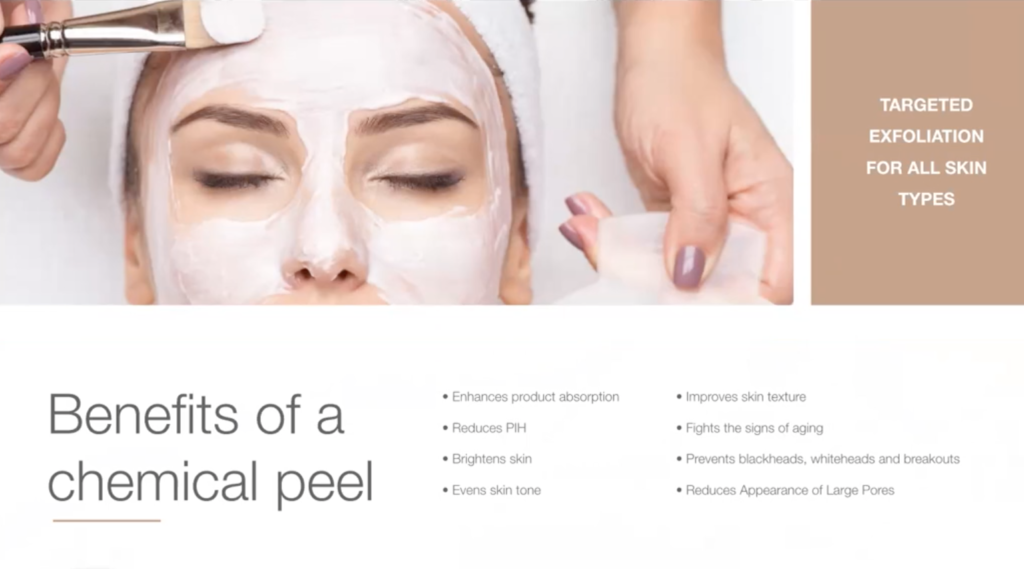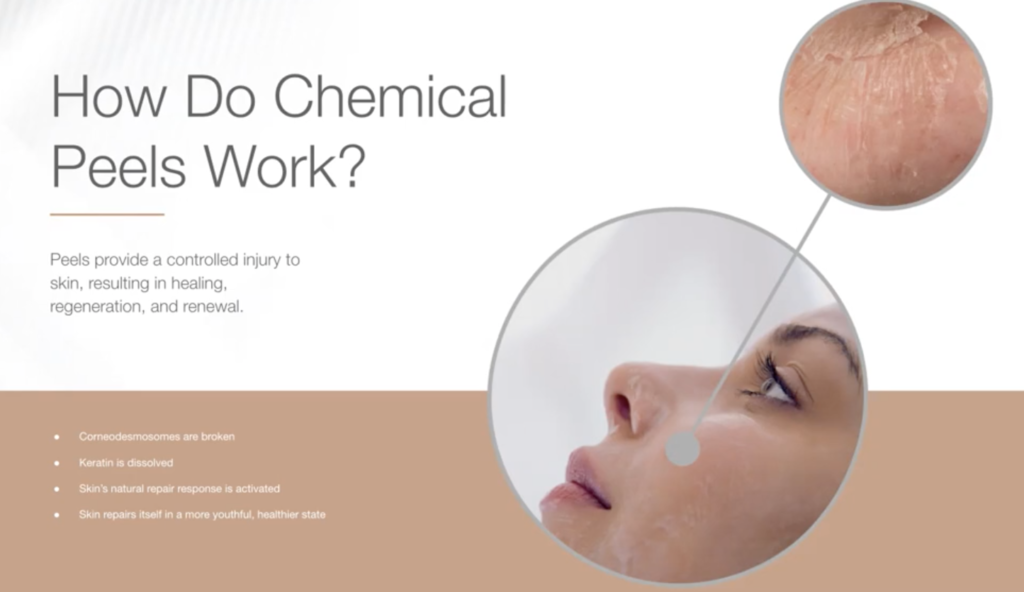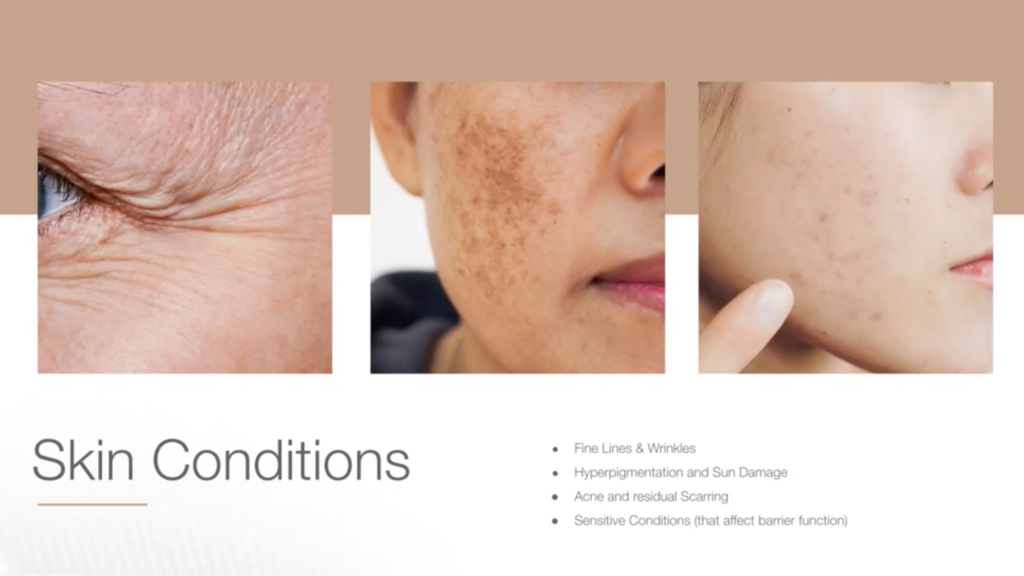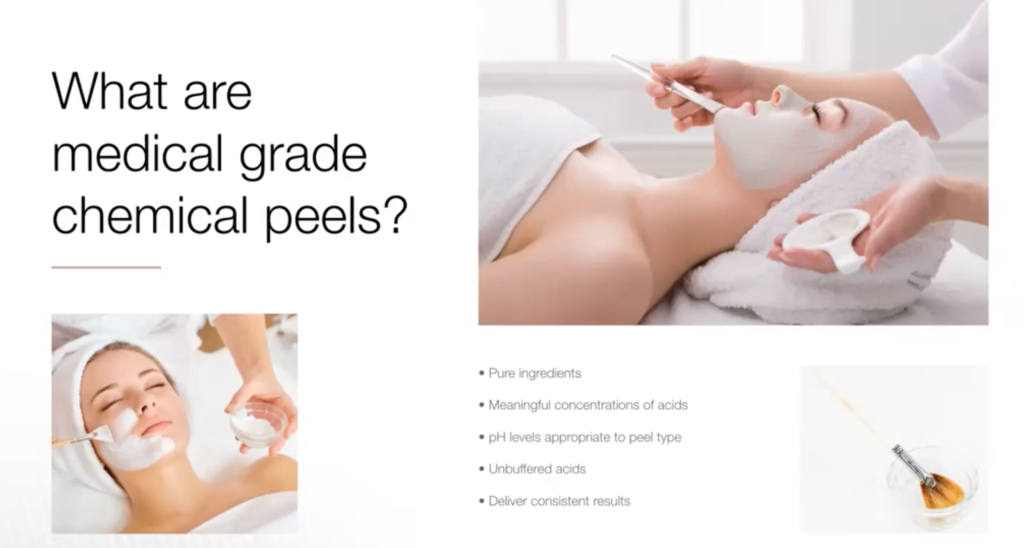A chemical peel is a cosmetic treatment used to improve the appearance of the skin on the face, neck, or hands. It involves applying a chemical solution to the skin, which causes the outer layers of the skin to peel off, revealing smoother, less wrinkled skin underneath.
Chemical peels provide significant results for a wide range of skin condition corrections, as well as numerous anti-aging and skin rejuvenation benefits.
Every year, chemical peels have consistently been in the top 5 most popular minimally invasive cosmetic procedures in the US.

Chemical peels offer several benefits for the skin, depending on the type and depth of the peel used. Here are the primary benefits of chemical peels:
Exfoliation and Skin Renewal:
- Chemical peels effectively remove dead skin cells from the outer layer of the skin (epidermis). This process promotes cell turnover and stimulates the growth of new skin cells, resulting in smoother, fresher-looking skin.
Improvement in Skin Texture:
- By exfoliating the skin, chemical peels can significantly improve skin texture. They help soften fine lines, wrinkles, and rough patches, making the skin appear smoother and more even-toned.
Reduction of Hyperpigmentation:
- Chemical peels can lighten and reduce the appearance of dark spots, sunspots, age spots, and other forms of hyperpigmentation. They help even out skin tone and fade discoloration caused by sun damage, hormonal changes, or acne scars.
Treatment of Acne and Acne Scarring:
- Certain types of chemical peels, such as those containing salicylic acid or glycolic acid, can help reduce acne breakouts and improve the appearance of acne scars. They unclog pores, reduce inflammation, and promote healing.
Stimulation of Collagen Production:
- Chemical peels can stimulate the production of collagen and elastin fibers in the deeper layers of the skin (dermis). This leads to improved skin elasticity, firmness, and overall skin rejuvenation.
Reduction of Fine Lines and Wrinkles:
- Medium to deep chemical peels can penetrate deeper into the skin, effectively reducing the appearance of moderate to severe wrinkles and lines. They encourage the growth of new skin cells and improve skin plumpness.
Control of Oil Production:
- Peels containing ingredients like salicylic acid can help regulate oil production in the skin, making them beneficial for individuals with oily or acne-prone skin.
Enhanced Absorption of Skincare Products:
- By removing the outer layer of dead skin cells, chemical peels improve the penetration and effectiveness of skincare products applied after the treatment. This allows for better absorption of moisturizers, serums, and other treatments.
Overall Skin Rejuvenation and Radiance:
- Chemical peels can give the skin a brighter, more youthful appearance by removing dull, damaged surface layers. They promote a healthier complexion and enhance skin radiance.
Boost in Confidence:
- Improving the appearance and health of the skin through chemical peels can boost self-esteem and confidence, as individuals often feel more comfortable and satisfied with their skin’s appearance.
What does chemical peels do?

Chemical peels are cosmetic treatments that utilize chemical solutions to improve the appearance and texture of the skin. They work by causing controlled exfoliation and peeling of the outer layers of the skin, leading to various benefits depending on the type and depth of the peel. Here are some of the primary effects and benefits of chemical peels:
Exfoliation and Skin Renewal: Chemical peels effectively remove dead skin cells from the outermost layer of the skin (epidermis). This process promotes cell turnover and stimulates the growth of new skin cells, resulting in smoother and more even-toned skin.
Improvement in Skin Texture: By removing the outer layer of damaged or rough skin, chemical peels can significantly improve skin texture. They can soften fine lines, wrinkles, and rough patches, making the skin appear smoother and more youthful.
Reduction of Hyperpigmentation: Chemical peels can lighten and reduce the appearance of dark spots, sunspots, age spots, and other forms of hyperpigmentation. They help even out skin tone and fade discoloration caused by sun damage, hormonal changes, or acne scars.
Treatment of Acne and Acne Scarring: Certain types of chemical peels, especially those containing salicylic acid or glycolic acid, can help reduce acne breakouts and improve the appearance of acne scars. They unclog pores, reduce inflammation, and promote healing.
Stimulation of Collagen Production: Chemical peels can stimulate the production of collagen and elastin fibers in the deeper layers of the skin (dermis). This leads to improved skin elasticity, firmness, and overall skin rejuvenation.
Reduction of Fine Lines and Wrinkles: Medium to deep chemical peels can penetrate deeper into the skin, effectively reducing the appearance of moderate to severe wrinkles and lines. They encourage the growth of new skin cells and improve skin plumpness.
Control of Oil Production: Peels containing ingredients like salicylic acid can help regulate oil production in the skin, making them beneficial for individuals with oily or acne-prone skin.
Enhanced Absorption of Skincare Products: By removing the outer layer of dead skin cells, chemical peels improve the penetration and effectiveness of skincare products applied after the treatment. This allows for better absorption of moisturizers, serums, and other treatments.
It’s important to note that the intensity and depth of a chemical peel determine its effects and downtime. Superficial peels typically require minimal downtime with mild redness or flaking, while deeper peels may involve several days to weeks of recovery time due to more significant peeling and potential side effects. Consulting with a qualified dermatologist or skincare professional is crucial to determine the most suitable type of chemical peel for your skin type, concerns, and desired outcomes
What types of conditions require peels?

The types of skin conditions that may benefit from chemical peels include:
Hyperpigmentation: Peels can help lighten dark spots, sunspots, melasma, and other forms of hyperpigmentation.
Acne and Acne Scarring: Peels can improve acne-prone skin by unclogging pores, reducing inflammation, and fading acne scars.
Fine Lines and Wrinkles: Peels can reduce the appearance of fine lines, wrinkles, and creases, especially on the face and neck.
Uneven Skin Tone and Texture: Peels can help smooth out rough skin texture and even out skin tone.
Sun Damage: Peels can address sun-damaged skin, including sunspots and photodamage.
Dryness and Dehydration: Peels can hydrate the skin and improve its overall moisture balance.
Dull or Lackluster Skin: Peels can rejuvenate and brighten dull skin, restoring a more radiant complexion.
Mild Scarring: Peels can help improve the appearance of mild scars, such as those from acne or minor injuries.
What is differnt standard Peels and Medical Grade Peels?

Chemical peels are categorized into several types based on the depth of penetration into the skin and the specific acids or ingredients used. The three main types of chemical peels are:
Superficial Peels:
- Also known as “lunchtime peels” or “light peels.”
- These peels use mild acids such as alpha-hydroxy acids (AHAs) like glycolic acid or beta-hydroxy acids (BHAs) like salicylic acid.
- They primarily work on the outer layer of the skin (epidermis) to exfoliate and improve skin texture.
- Superficial peels are suitable for treating mild discoloration, rough skin, and enhancing the skin’s glow.
- Minimal downtime is required, with mild redness or flaking that resolves quickly.
Medium Peels:
- These peels penetrate into the middle layer of the skin (dermis), beyond the epidermis.
- They typically use stronger acids such as trichloroacetic acid (TCA) or a combination of acids to target deeper skin concerns.
- Medium peels are effective for treating moderate skin discoloration, fine lines, wrinkles, and acne scars.
- They may require a few days to a week of downtime, with redness, swelling, and peeling as common side effects.
Deep Peels:
- Deep peels penetrate deeply into the middle to lower layers of the dermis.
- They use potent acids such as phenol to address severe skin issues like deep wrinkles, significant sun damage, and scars.
- Deep peels provide more dramatic results but require the longest recovery time.
- Recovery can take weeks to heal completely, with potential side effects such as swelling, redness, and peeling that may be more pronounced.
Each type of chemical peel offers different levels of exfoliation and skin rejuvenation, catering to varying skin concerns and conditions. The choice of peel type depends on factors such as the severity of skin issues, skin type, downtime tolerance, and desired results. It’s essential to consult with a qualified dermatologist or skincare professional to determine the most suitable type of chemical peel for your specific needs and to ensure safety and optimal results.
Book Chemical Peels Today
Book a chemical peels package today and discover the incredible benefits for yourself!
